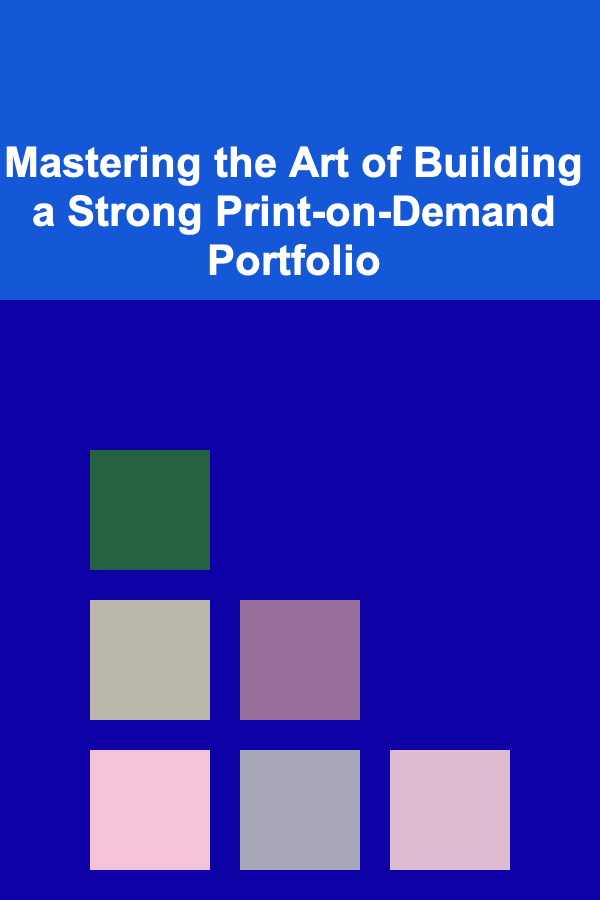
Mastering the Art of Building a Strong Print-on-Demand Portfolio
ebook include PDF & Audio bundle (Micro Guide)
$12.99$5.99
Limited Time Offer! Order within the next:

In the dynamic world of e-commerce, Print-on-Demand (POD) has emerged as a powerful business model, offering entrepreneurs the opportunity to sell custom-designed products without the burden of upfront inventory costs. However, simply setting up a POD store isn't enough to guarantee success. Building a strong and compelling portfolio is crucial for attracting customers, establishing brand authority, and achieving long-term growth. This comprehensive guide delves into the intricacies of creating a POD portfolio that not only showcases your artistic talents but also maximizes your earning potential.
Understanding the Fundamentals of a POD Portfolio
Before diving into the specifics, it's essential to understand what constitutes a strong POD portfolio. It's more than just a collection of your designs; it's a curated representation of your brand, target audience, and design philosophy. A well-crafted portfolio should:
- Showcase your design skills: Demonstrate your versatility and creativity across various design styles and product categories.
- Target a specific niche: Focusing on a particular niche allows you to attract a dedicated audience and establish yourself as an expert in that area.
- Reflect your brand identity: Maintain a consistent aesthetic and messaging that aligns with your brand values.
- Highlight popular trends: Incorporate trending themes and designs that resonate with current consumer preferences.
- Include high-quality mockups: Present your designs on realistic product mockups to give customers a clear idea of what they're buying.
- Be well-organized and easy to navigate: Ensure that your portfolio is user-friendly and allows customers to easily find the designs they're looking for.
- Be regularly updated: Continuously add new designs to keep your portfolio fresh and engaging.
Think of your portfolio as your online storefront. It's the first impression you make on potential customers, and it needs to be visually appealing, informative, and persuasive.
Identifying Your Niche and Target Audience
One of the most critical steps in building a successful POD portfolio is identifying your niche and target audience. Trying to appeal to everyone will ultimately appeal to no one. A niche focus allows you to:
- Reduce competition: By focusing on a specific area, you can avoid competing with larger, more established brands that cater to a broad audience.
- Attract a loyal following: Customers who are passionate about a particular niche are more likely to become repeat buyers and brand advocates.
- Improve your marketing efforts: Targeted marketing campaigns are more effective and cost-efficient than broad, generic campaigns.
- Develop expertise: By focusing on a specific niche, you can become an expert in that area and offer unique value to your customers.
How to Identify Your Niche:
- Brainstorm your interests and passions: What are you passionate about? What are your hobbies? What are you knowledgeable about? This is a great starting point for identifying potential niches.
- Research market trends: Use tools like Google Trends, social media analytics, and keyword research to identify trending topics and popular niches.
- Analyze the competition: Look at existing POD stores and identify niches that are underserved or have room for innovation.
- Consider your target audience: Who are you trying to reach? What are their interests, demographics, and pain points?
- Test different niches: Experiment with different niches to see which ones resonate with your audience and generate the most sales.
Understanding Your Target Audience:
Once you've identified your niche, it's essential to understand your target audience. This involves researching their demographics, interests, purchasing habits, and pain points. This information will help you create designs and marketing messages that resonate with them. Consider creating buyer personas -- fictional representations of your ideal customers -- to help you better understand their needs and motivations. Ask yourself:
- What are their ages, genders, and locations?
- What are their interests, hobbies, and passions?
- What are their values and beliefs?
- What are their pain points and challenges?
- Where do they spend their time online?
- What are their purchasing habits?
By thoroughly understanding your target audience, you can create a POD portfolio that caters specifically to their needs and preferences.
Creating High-Quality Designs
The quality of your designs is paramount to the success of your POD business. Customers are more likely to purchase and recommend products with visually appealing and well-executed designs. Here are some key considerations for creating high-quality designs:
- Originality: Strive to create original designs that stand out from the competition. Avoid using generic or overused graphics. While inspiration is important, ensure your designs are unique and reflect your personal style.
- Resolution: Use high-resolution images and graphics to ensure that your designs look crisp and clear when printed on products. A minimum resolution of 300 DPI (dots per inch) is generally recommended.
- Color Palette: Choose a color palette that is visually appealing and appropriate for your target audience and niche. Consider the psychology of colors and how they can evoke different emotions.
- Typography: Use clear and legible fonts that complement your designs. Pay attention to font size, spacing, and kerning to ensure readability.
- Copyright: Ensure that you have the necessary rights and permissions to use all elements in your designs, including images, fonts, and graphics. Avoid infringing on trademarks or copyrights.
- Testing: Before making your designs available for sale, test them on different products to ensure that they look good and print properly. Order samples to verify the quality of the prints.
Tools and Resources for Design Creation:
- Adobe Photoshop: A professional-grade image editing software for creating and editing raster graphics.
- Adobe Illustrator: A vector graphics editor for creating scalable designs that can be used on various products.
- Canva: A user-friendly design platform with a wide range of templates and tools for creating visually appealing designs.
- Procreate: A digital art app for iPad that allows you to create stunning illustrations and designs.
- GIMP: A free and open-source image editor that is a great alternative to Photoshop.
- Inkscape: A free and open-source vector graphics editor that is a great alternative to Illustrator.
- Creative Market: A marketplace for design assets, including fonts, graphics, and templates.
- Envato Elements: A subscription-based service that provides access to a vast library of design assets.
Investing in quality design tools and continuously honing your design skills is crucial for creating a compelling POD portfolio.
Selecting the Right Products
The products you choose to feature in your POD portfolio can significantly impact your sales and brand perception. Select products that are:
- Relevant to your niche: Choose products that are relevant to your target audience's interests and needs.
- High-quality: Select products that are made from durable materials and have a good reputation for print quality. Research the POD providers you're using and read reviews about their product quality.
- Profitable: Consider the profit margins of different products and choose those that offer a good balance between price and quality. Factor in the cost of the product, the printing cost, and your desired profit margin.
- Trendy: Incorporate trending products that are popular with your target audience. Keep an eye on current fashion trends, social media trends, and seasonal trends.
- Varied: Offer a variety of products to cater to different customer preferences and budgets. Consider offering different sizes, colors, and styles.
Popular POD Products:
- T-shirts: A classic and versatile product that is always in demand.
- Hoodies: A popular choice for colder weather and casual wear.
- Mugs: A practical and affordable product that can be customized with a variety of designs.
- Phone cases: A popular accessory that can be personalized with unique designs.
- Posters: A great way to showcase your artwork and add personality to any room.
- Tote bags: A reusable and eco-friendly alternative to plastic bags.
- Stickers: A fun and affordable way to express your creativity.
- Hats: A stylish accessory that can be customized with logos or designs.
- Wall art: Canvases, framed prints, and metal prints offer a premium option for customers looking to decorate their homes.
- Home Decor: Pillows, blankets, and shower curtains are popular choices for adding a personal touch to home interiors.
Don't be afraid to experiment with different products to see what resonates with your audience. Track your sales data to identify your best-selling products and focus on expanding those categories.
Creating Compelling Mockups
Product mockups are essential for showcasing your designs in a realistic and appealing way. High-quality mockups can help customers visualize how your designs will look on the actual products and can significantly increase your sales. Here are some tips for creating compelling mockups:
- Use realistic mockups: Choose mockups that accurately represent the products you're selling. Look for mockups that have good lighting, realistic textures, and accurate proportions.
- Showcase your designs in different settings: Use mockups that showcase your designs in different settings to give customers a better idea of how they can be used. For example, you could use a mockup of a t-shirt being worn by a person, or a mockup of a mug sitting on a desk.
- Use high-resolution mockups: Use high-resolution mockups to ensure that your designs look crisp and clear.
- Customize your mockups: Customize your mockups to match your brand's aesthetic. You can add your logo, change the background color, or add text.
- Use different angles and perspectives: Showcase your designs from different angles and perspectives to give customers a comprehensive view of the product.
- Consider using video mockups: Video mockups can be a great way to showcase your designs in a dynamic and engaging way.
Resources for Creating Mockups:
- Placeit: A popular online mockup generator with a wide range of templates and products.
- Mockup World: A website that offers a collection of free and premium mockups.
- GraphicBurger: A website that offers a variety of free and premium design resources, including mockups.
- Adobe Photoshop: You can create your own mockups in Photoshop using smart objects.
- Canva: Canva also has mockup features, although more limited than specialized mockup tools.
Investing in high-quality mockups is a worthwhile investment that can significantly improve your sales and brand perception.
Organizing and Presenting Your Portfolio
The way you organize and present your portfolio can significantly impact the user experience and your conversion rates. A well-organized portfolio should be:
- Easy to navigate: Customers should be able to easily find the designs they're looking for. Use clear and intuitive navigation menus and categories.
- Visually appealing: Your portfolio should be visually appealing and consistent with your brand's aesthetic. Use high-quality images and a clean, uncluttered design.
- Mobile-friendly: Ensure that your portfolio is responsive and looks good on all devices, including smartphones and tablets. A significant portion of online traffic comes from mobile devices.
- Searchable: Implement a search function that allows customers to easily find designs by keyword.
- Categorized: Organize your designs into categories to make it easier for customers to browse. Categories can be based on niche, product type, or design style.
- Tagged: Tag your designs with relevant keywords to improve searchability and categorization.
- Fast-loading: Optimize your images and website code to ensure that your portfolio loads quickly. Slow loading times can lead to high bounce rates.
Platform Options for Hosting Your Portfolio:
- Shopify: A popular e-commerce platform that offers a wide range of features for creating and managing your online store. Shopify integrates seamlessly with many POD providers.
- Etsy: A marketplace for handmade and vintage items, as well as craft supplies. Etsy can be a great platform for reaching a niche audience.
- WooCommerce (WordPress): A free e-commerce plugin for WordPress that allows you to create a custom online store. WooCommerce offers a high degree of flexibility and customization.
- Printful: While Printful is a POD provider, they also offer the ability to create a storefront through their platform.
- Your Own Website: Building a website from scratch (using platforms like Squarespace or Wix) gives you maximum control over design and branding but requires more technical effort.
Choose a platform that is appropriate for your needs and technical skills. Consider the costs, features, and scalability of each platform before making a decision.
Marketing Your POD Portfolio
Creating a strong POD portfolio is only half the battle. You also need to effectively market your portfolio to attract customers and generate sales. Here are some marketing strategies to consider:
- Social Media Marketing: Use social media platforms like Instagram, Facebook, Pinterest, and TikTok to showcase your designs, engage with your audience, and drive traffic to your store. Post regularly, use relevant hashtags, and run targeted ads.
- Search Engine Optimization (SEO): Optimize your website and product listings for search engines to improve your visibility in search results. Use relevant keywords in your titles, descriptions, and tags.
- Email Marketing: Build an email list and send out regular newsletters to promote new designs, offer discounts, and engage with your subscribers.
- Paid Advertising: Use paid advertising platforms like Google Ads and Facebook Ads to reach a wider audience. Target your ads based on demographics, interests, and behaviors.
- Influencer Marketing: Partner with influencers in your niche to promote your designs to their followers.
- Content Marketing: Create valuable and engaging content that is relevant to your target audience. This could include blog posts, articles, videos, or infographics.
- Promotions and Discounts: Offer promotions and discounts to incentivize purchases and attract new customers.
- Collaborations: Collaborate with other designers or brands to cross-promote your products and reach new audiences.
Develop a comprehensive marketing plan that outlines your goals, target audience, strategies, and budget. Track your results and make adjustments as needed.
Analyzing and Optimizing Your Portfolio
Building a strong POD portfolio is an ongoing process. It's essential to continuously analyze your performance and make adjustments to optimize your results. Here are some key metrics to track:
- Website traffic: Track the number of visitors to your website and the sources of your traffic.
- Conversion rate: Track the percentage of visitors who make a purchase.
- Average order value: Track the average amount of money spent per order.
- Customer acquisition cost: Track the cost of acquiring a new customer.
- Customer lifetime value: Track the total revenue generated by a customer over their relationship with your business.
- Sales per product: Track which products are selling well and which are not.
- Customer feedback: Collect and analyze customer feedback to identify areas for improvement.
Use this data to identify what's working and what's not. Make adjustments to your designs, products, marketing strategies, and website to improve your performance. A/B testing can be a valuable tool for testing different design variations, product offerings, or marketing messages to see which ones perform best.
Key Takeaways for Building a Powerful POD Portfolio
Mastering the art of building a strong print-on-demand portfolio requires a combination of artistic talent, business acumen, and a commitment to continuous improvement. Here's a summary of the key takeaways:
- Niche Down: Focus on a specific niche to attract a loyal audience and reduce competition.
- High-Quality Designs are Essential: Create original, high-resolution designs that are visually appealing and relevant to your target audience.
- Product Selection Matters: Choose high-quality, profitable products that align with your niche and target audience.
- Mockups are Crucial: Use realistic and compelling mockups to showcase your designs in the best possible light.
- Organize for Success: Organize and present your portfolio in a way that is easy to navigate, visually appealing, and mobile-friendly.
- Market Strategically: Develop a comprehensive marketing plan that utilizes social media, SEO, email marketing, and paid advertising.
- Analyze and Optimize Continuously: Track your performance, analyze your data, and make adjustments to optimize your results.
- Stay Updated: Keep up with current trends in design, e-commerce, and marketing to stay ahead of the curve.
By following these guidelines and continuously refining your approach, you can create a POD portfolio that attracts customers, generates sales, and establishes you as a successful entrepreneur in the exciting world of print-on-demand.

How to Celebrate Milestones and Progress Along the Way
Read More
How to Collect and Analyze Event Data for Insights
Read More
How to Leverage Technology for Business Growth
Read More
How to Set Up a DIY Cocktail Bar for Your Home Party
Read More
How To Get Rid of Puffy Eyes Fast
Read More
How to Discover Underrated Series from Different Countries
Read MoreOther Products

How to Celebrate Milestones and Progress Along the Way
Read More
How to Collect and Analyze Event Data for Insights
Read More
How to Leverage Technology for Business Growth
Read More
How to Set Up a DIY Cocktail Bar for Your Home Party
Read More
How To Get Rid of Puffy Eyes Fast
Read More